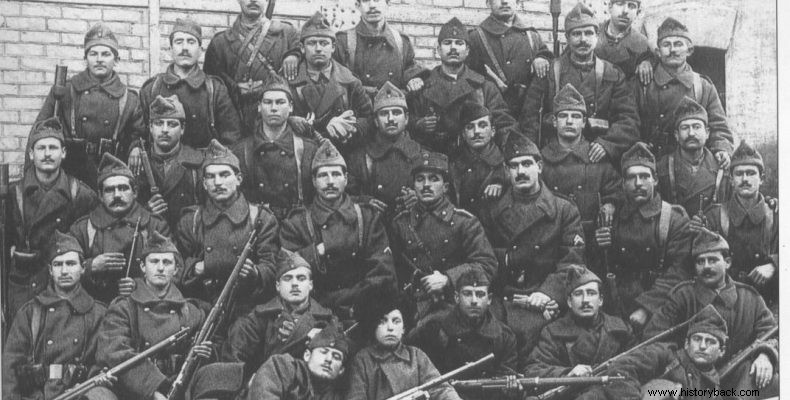
In 1919, the First Army Corps (SS) was sent, at the request of the Allies, to "Southern Russia", today's Ukraine, to fight, despite the side of French and Russian "white" forces, against the Bolsheviks.
In this context, the main forces of the First SS landed, gradually, from Odessa to Kherson, the 2nd Infantry Regiment (SP) of the XIII Infantry Division (MP) landed on March 10 (old calendar) in Sevastopol, Crimea. The military situation the Greeks found there was anything but pleasant. The Crimean peninsula was connected to the mainland by an isthmus that had three branches.
The 9 km wide Perekop isthmus, the westernmost of the three, the man-made, silted central branch of the Dnepropetrovsk and the third branch of the Arabat, also man-made. Through these branches passed all the roads and railway lines that connected the peninsula with the North.
The defense of these branches was undertaken by the "white" Russian forces. These bore the pompous title "Russian Volunteer Army" and had two "divisions". However, the total strength of the "army" did not exceed 4,000 men. The French 157th Infantry Division was also in the Crimea, but it numbered only 500 men. There were even German units stationed in the Crimea awaiting their transfer to Germany.
Against them, these forces had in principle the Bolsheviks of the Crimea who were numerous, while from time to time the invasion of the peninsula was expected by other Bolshevik forces estimated at at least 20,000 men. The first attempts of the Bolsheviks to cross the Isthmus of Perekop failed thanks to the assistance of the French military.
The 2nd Constitution
The 2nd SP did not arrive complete in Sevastopol. Its commander, Lt. Col. Neokosmos Grigoriadis, had the I/2 and II/2 Infantry Battalions (TP) without the transports of their machine gun companies, the staff of the III/2 TP and its 9th Company and the XIIIa Surgery. In total the regiment had 2,038 men, 30 two-wheeled carriages and 30 animals with limited ammunition.
60,000 Greeks lived in Crimea at that time. The thought of recruiting between them was then born but it did not proceed. The 2nd SP arrived in the city at a time when it was being rocked by a major strike involving at least 15,000 Bolshevik sympathizers. The French were unable to impose order. So with the arrival of the Greeks the French commander colonel Rouillet took over. And indeed this was achieved.
Simferoupolis and thinning
On March 13, the French command ordered the I/2 TP, under Major Vasilios Mitsakos, to move to Simferoupoli where it would assume guard duties. So it happened. The next day, however, the French ordered the battalion to send its 1st Company (Lieutenant Palaska Kon/nos) reinforced with a machine gun platoon to go to Jankoi replacing "white" Russian forces so that they could reinforce their compatriots on the isthmus.
There the Greek section suffered its first losses (1 dead, 1 wounded) in a Bolshevik ambush. On March 15, the 2nd company (Lieutenant Papadimitropoulos Ipp.) was ordered to be deployed in the village of Taganas to guard the railway station. Thus, a Greek battalion had escalated to a range of 100 km. On March 17, the 4th Platoon of Transport Vehicles landed in Sevastopol, which was subordinated to the 2nd SP.
Battle of Yosun
In the meantime, important events were taking place in the passes in the "neck" of the Crimea. On March 22, nine Bolshevik regiments passed through the shallows of Perekop and found themselves behind the approximately 700 "white" Russians guarding the isthmus.
The French colonel Trousson, who had meanwhile taken command, ordered the 1st Company to rush to reinforce the Russians. The Company arrived on March 23 at Yusun and joined the Russians. The Greeks attacked and, dragging the Russians with their momentum, pushed back the Bolshevik vanguards.
The Greek company lined up in the center of the defensive formation with Russian divisions on its flanks. But soon the Bolsheviks put the Russians to flight on the left side of the formation and the Greek side was left uncovered.
Lieutenant Palaskas ordered a retreat, but he himself was killed. Nevertheless the company retreated in order with all its material. Losses were heavy (12 dead, 24 wounded). But the 2nd Company had also been ordered to move towards Perekop. But there he encountered strong Bolshevik forces. He managed to retreat fighting but was cut off from the battalion.
Evacuation
After these developments and as the Bolshevik forces were now flooding the area, it was decided to evacuate Simferoupoli. The Greek forces withdrew in order. In the meantime the 2nd Company also managed to rescue itself with the help of a Navy ship.
In the meantime, the Bolsheviks began to attack Sevastopol from April 2. The 2nd SP, which essentially fought only defending the city, had to face, in addition to the numerous opponents outside the city, those inside who were attacking the Greek forces from the south.
In addition, the Greeks had to deal with the French sailors who opened fire on them. The Greeks returned fire and injured three Frenchmen. However, the French administration ordered the evacuation of the city. The 2nd SP left in absolute order, even compensating citizens due to warrants or damages.
This highly political move by Lt. Col. Grigoriadis excited the Bolsheviks who ordered that the Greeks not be harmed. The 2nd SP in the Crimean operations had 19 dead and 41 wounded.
